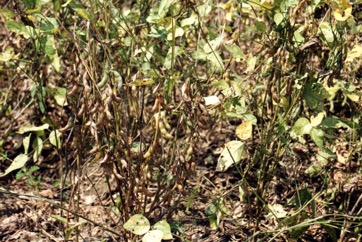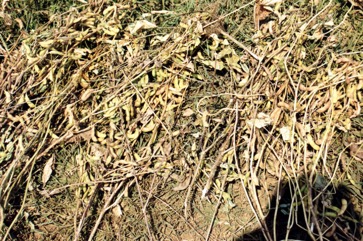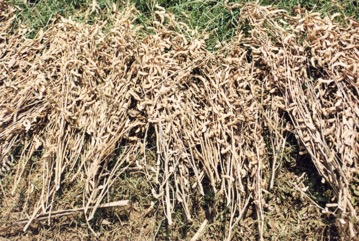Soybean

It is a temperate plant. It suits lowland areas. It can be grown from sea level to 2,100 m altitude. Many varieties will not flower in the tropics (short days). It needs fertile soil. The best soil acidity is pH 5.5 to 7.0. It is damaged by frost. In Nepal it grows to 1800 m altitude. It suits hardiness zones 7-8. In Yunnan.
Also known as:
Bekan, Ber-hrum, Bhatamas, Bhatmas, Da hou, Daizu, Dau-nanh, Dekeman, Edu mame, Feve de soja, Fore-keli Frijol soya, Gadele, Hak dau, Hsan-to-nouk, Huang dou, Jaa jang, Kacang kedalai, Kacang soya, Kachang bulu rimau, Kachang jepun, Kachang kedele, Kadele, Kedalai, Manchurian bean, Mao dau, Nga-see, Peayak, Pe-bok, Pe-ngapi, Sanndaek sieng, Soia, Soja bean, Sojabohne, Soya bean, Tai dau, Thua lueang, Tua luang, Utaw, Wong dau
Synonyms
- Dolichos soja L.
- Glycine gracilis Skvortsov
- Glycine hispida (Moench) Maxim.
- Glycine hispida var. brunnea Skvortzov
- Glycine hispida var. lutea Skvortzov
- Glycine soja (L.) Merr., nom. illeg.
- Phaseolus max L.
- Soja angustifolia Miq.
- Soja hispida Moench
- Soja japonica Savi
- Soja max (L.) Piper
- Soja viridis Savi
Edible Portion
- Seeds, Leaves, Spice, Vegetable
Where does Soybean grow?
Found in: Afghanistan, Africa, Angola, Argentina, Asia, Australia, Bangladesh, Benin, Bhutan, Bolivia, Brazil, Bulgaria, Burkina Faso, Burundi, Cambodia, Cameroon, Canada, Caribbean, Caucasus, Central Africa, Central America, Central Asia, Chile, China, Colombia, Congo DR, Cook Islands, Côte d'Ivoire, Cuba, Czech Republic, Dominican Republic, East Africa, East Timor, Ecuador, Egypt, Ethiopia, Europe, Fiji, France, Georgia, Ghana, Guatemala, Guyana, Haiti, Hawaii, Himalayas, Hungary, India, Indochina, Indonesia, Iran, Iraq, Italy, Ivory Coast, Jamaica, Japan, Kazakhstan, Kenya, Korea, Kyrgyzstan, Laos, Liberia, Madagascar, Malawi, Malaysia, Manchuria, Mauritius, Mexico, Mongolia, Morocco, Mozambique, Myanmar, Nepal, New Zealand, Nigeria, North Africa, North America, Northeastern India, Pacific, Pakistan, Papua New Guinea, PNG, Paraguay, Peru, Philippines, Korea, Romania, Russia, Rwanda, SE Asia, Senegal, Serbia, Sikkim, Slovakia, Slovenia, South Africa, Southern Africa, South America, South Sudan, Spain, Sri Lanka, Sudan, Switzerland, Taiwan, Tajikistan, Tanzania, Tasmania, Thailand, Timor-Leste, Turkey, Uganda, Uruguay, United States, Venezuela, Vietnam, West Africa, West Indies, West Timor, Yugoslavia, Zambia, Zimbabwe
Notes: There are 10 Glycine species.
Status: These beans can be found in small amounts in many places throughout the country of Papua New Guinea. Soybean is a major food plant in warm temperate and subtropical zones. Over 100 million tons are produced each year.
Growing Soybean
Cultivation: It is grown from seed. Seeds need to be inoculated with bacteria before planting. The correct one is Bradyrhizobium japonicum. Plants need to be about 20 cm apart.
Edible Uses: The young pods and ripe seeds are eaten. They are used for flour. The dried seeds are boiled or baked and used in soups, stews and casseroles. The seeds are used for oil. Toasted seeds are eaten like a snack. Strongly roasted seeds are used for coffee. Soy flour is used for noodles, pasta, confectionary and other foods. The beans are fermented and used in a range of foods. Sometimes the young leaves are eaten. The seeds are also used for sprouts and for making cooking oil and soya sauce etc. Because soybean contains a trypsin inhibitor they should be cooked and even the sprouts should be lightly cooked.
Production: Plants flower about 8 weeks after sowing and pods mature about 16 weeks after sowing. Often plants are pulled up and hung up before threshing out the seed.
Nutrition Info
per 100g edible portion| Edible Part | Energy (kcal) | Protein (g) | Iron (mg) | Vitamin A (ug) | Vitamin c (mg) | Zinc (mg) | % Water |
|---|---|---|---|---|---|---|---|
| Seeds | 407 | 33.7 | 6.1 | 55 | - | - | 9 |
| Immature Seeds | 140 | 13 | 3.8 | 16 | 27 | 0.9 | 68 |
| Seeds sprouted | 81 | 8.5 | 1.3 | 1 | 8.3 | 1 | 79.5 |
Soybean Photos



References
Ambasta, S.P. (Ed.), 2000, The Useful Plants of India. CSIR India. p 239
Anderson, E. F., 1993, Plants and people of the Golden Triangle. Dioscorides Press. p 212
Bianchini, F., Corbetta, F., and Pistoia, M., 1975, Fruits of the Earth. Cassell. p 234 (As Soja hispida)
Bremness, L., 1994, Herbs. Collins Eyewitness Handbooks. Harper Collins. p 251
Brown, D., 2002, The Royal Horticultural Society encyclopedia of Herbs and their uses. DK Books. p 224
Burkill, I.H., 1966, A Dictionary of the Economic Products of the Malay Peninsula. Ministry of Agriculture and Cooperatives, Kuala Lumpur, Malaysia. Vol 1 (A-H) p 1096
Bussman, R. W., et al, 2016, A comparative ethnobotany of Khevsureti, Samtskhe-Javakheti, Tusheti, Svaneti, and Racha-Lechkhumi, Republic of Georgia (Sakartvelo), Caucasus. Journal of Ethnobiology and Ethnomedicine (2016) 12:4
Bussman, R. W. et al, 2017, Ethnobotany of Samtskhe-Javakheti, Sakartvelo (Republic of Georgia), Caucasus. Indian Journal of Traditional Knowledge Vol. 16(1) pp 7-24
Cheifetz, A., (ed), 1999, 500 popular vegetables, herbs, fruits and nuts for Australian Gardeners. Random House p 68
Chin, H. F., 1999, Malaysian Vegetables in Colour. Tropical Press. p 31
Cobley, L.S. (rev. Steele, W.M.) 2nd Ed., 1976, An Introduction to the Botany of Tropical Crops. Longmans. p 85
Creasy, R., 2000, The Edible Asian Garden. Periplus p 24
Cundall, P., (ed.), 2004, Gardening Australia: flora: the gardener's bible. ABC Books. p 644
Facciola, S., 1998, Cornucopia 2: a Source Book of Edible Plants. Kampong Publications, p 105
Flora of Pakistan. www.eFloras.org
Foo, J.T.S.(ed), 1996, A Guide to Common Vegetables. Singapore Science Foundation. p 84
Fox, F. W. & Young, M. E. N., 1982, Food from the Veld. Delta Books. p 226
French, B.R., 1986, Food Plants of Papua New Guinea, A Compendium. Asia Pacific Science Foundation p 39
French, B.R., 2010, Food Plants of Solomon Islands. A Compendium. Food Plants International Inc. p 53
Gangte, H. E., et al, 2013, Wild Edible Plants used by the Zou Tribe in Manipur, India. International Journal of Scientific and Research Publications, Volume 3, Issue 5
Giller, K.E. & Dashiell, K.E., 2007. Glycine max (L.) Merr. [Internet] Record from Protabase. van der Vossen, H.A.M. & Mkamilo, G.S. (Editors). PROTA (Plant Resources of Tropical Africa), Wageningen, Netherlands. < http://database.prota.org/search.htm>. Accessed 16 October 2009.
Grubben, G. J. H. and Denton, O. A. (eds), 2004, Plant Resources of Tropical Africa 2. Vegetables. PROTA, Wageningen, Netherlands. p 562
Guite, C., 2016, A study of wild edible plants associated with the Paite tribe of Manipur, India, International Journal of Current Research. Vol. 8, Issue, 11, pp. 40927-40932
Hedrick, U.P., 1919, (Ed.), Sturtevant's edible plants of the world. p 330 (As Glycine soja)
http://palaeoworks.anu.edu.au/Nuno_PhD/04.pdf re Timor
Hu, Shiu-ying, 2005, Food Plants of China. The Chinese University Press. p 474
Hymowitz, T., 1979, Soybeans, in Simmonds N.W.,(ed), Crop Plant Evolution. Longmans. London. p 159
Interpr. Herb. amboin. 274. 1917
Jacquat, C., 1990, Plants from the Markets of Thailand. D.K. Book House p 49
Jardin, C., 1970, List of Foods Used In Africa, FAO Nutrition Information Document Series No 2.p 25
Khanal, R., et al, 2014, Documenting abundance and use of underutilized plant species in the mid hill region of Nepal. ECOPRINT 21: 63-71, 2014
Kiple, K.F. & Ornelas, K.C., (eds), 2000, The Cambridge World History of Food. CUP p 434, 1855
Kybal, J., 1980, Herbs and Spices, A Hamlyn Colour Guide, Hamlyn Sydney p 100
Larkcom, J., 1991, Oriental Vegetables, John Murray, London, p 60
Latham, P., 2004, Useful Plants of Bas-Congo province. Salvation Army & DFID p 139
Lazarides, M. & Hince, B., 1993, Handbook of Economic Plants of Australia, CSIRO. p 122
Macmillan, H.F. (Revised Barlow, H.S., et al) 1991, Tropical Planting and Gardening. Sixth edition. Malayan Nature Society. Kuala Lumpur. p 323
Manandhar, N.P., 2002, Plants and People of Nepal. Timber Press. Portland, Oregon. p 247
Martin, F.W. & Ruberte, R.M., 1979, Edible Leaves of the Tropics. Antillian College Press, Mayaguez, Puerto Rico. p 199
Medhi, P. & Borthakur, S. K., 2012, Phytoresources from North Cachur Hills of Assam -3: Edible plants sold at Hflong market. Indian Journal or Natural Products and Resources. 3(1) pp 84-109
Miguel, E., et al, 1989, A checklist of the cultivated plants of Cuba. Kulturpflanze 37. 1989, 211-357
Molares, S. & Ladio, A., 2012, The Usefulness of Edible and Medicinal Fabaceae in Argentine and Chilean Patagonia: Environmental Availability and Other Sources of Supply. Evidence-Based Complementary and Alternative Medicine. Volume 2012, Article ID 901918, 12 pages, Hindawi Publishing Corporation.
Mulherin, J., 1994, Spices and natural flavourings. Tiger Books, London. p 84
Murtem, G. & Chaudhrey, P., 2016, An ethnobotanical note on wild edible plants of Upper Eastern Himalaya, India. Brazilian Journal of Biological Sciences, 2016, v. 3, no. 5, p. 63-81.
Ochse, J.J. et al, 1931, Vegetables of the Dutch East Indies. Asher reprint. p 389 (As Glycine soja)
Omawale, 1973, Guyana's edible plants. Guyana University, Georgetown p 108
Owen, S., 1993, Indonesian Food and Cookery, INDIRA reprints. p 63
Pham-Hoang Ho, 1999, An Illustrated Flora of Vietnam. Nha Xuat Ban Tre. p 949
Phon, P., 2000, Plants used in Cambodia. © Pauline Dy Phon, Phnom Penh, Cambodia. p 318
Plants for a Future database, The Field, Penpol, Lostwithiel, Cornwall, PL22 0NG, UK. http://www.scs.leeds.ac.uk/pfaf/
Plants of Haiti Smithsonian Institute http://botany.si.edu/antilles/West Indies
Purseglove, J.W., 1968, Tropical Crops Dicotyledons, Longmans. p 265
Rashid, H. E., 1977, Geography of Bangladesh. Westview. p 262 (As Glycine hispida)
Recher, P, 2001, Fruit Spirit Botanical Gardens Plant Index. www.nrg.com.au/~recher/ seedlist.html p 2
Ruiters-Welcome, A. K., 2019, Food plants of southern Africa. Ph.D. thesis. Univ. of Johannesburg p 58
Schneider, E., 2001, Vegetables from Amaranth to Zucchini: The essential reference. HarperCollins. p 66
Segnon, A. C. & Achigan-Dako, E. G., 2014, Comparative analysis of diversity and utilization of edible plants in arid and semi-arid areas in Benin. Journal of Ethnobiology and Ethnomedicine 2014, 10:80
Seidemann J., 2005, World Spice Plants. Economic Usage, Botany, Taxonomy. Springer. p 167
Shah, S. K., 2014, Dietary contribution of underutilized minor crops and indigenous plants collected from uncultivated lands and forests in Nepal. in Promotion of Underutilized Indigenous Food Resources for Food Security and Nutrition in Asia and Pacific. FAO. Bangkok p 64
Smith, A.C., 1985, Flora Vitiensis Nova, Lawaii, Kuai, Hawaii, Volume 3 p 229
Solomon, C., 2001, Encyclopedia of Asian Food. New Holland. p 349
Song, M., et al, 2013, Traditional knowledge of wild edible plants in Jeju Island, Korea. Indian Journal of Traditional Knowledge. 12(2) pp 177-194
Staples, G.W. and Herbst, D.R., 2005, A tropical Garden Flora. Bishop Museum Press, Honolulu, Hawaii. p 318
Sukenti, K., et al, 2016, Ethnobotanical study on local cuisine of the Sasak tribe in Lombok Island, Indonesia. Journal of Ethnic Foods. 3 (2016) 189-200 p 198
Terra, G.J.A., 1973, Tropical Vegetables. Communication 54e Royal Tropical Institute, Amsterdam, p 49
Tindall, H.D., & Williams, J.T., 1977, Tropical Vegetables and their Genetic Resources, International Board for Plant Genetic Resources, Rome, p 77
Tindall, H.D., 1983, Vegetables in the Tropics, Macmillan p 265
USDA, ARS, National Genetic Resources Program. Germplasm Resources Information Network - (GRIN). [Online Database] National Germplasm Resources Laboratory, Beltsville, Maryland. Available: www.ars-grin.gov/cgi-bin/npgs/html/econ.pl (10 April 2000)
van Wyk, B., 2005, Food Plants of the World. An illustrated guide. Timber press. p 201
Verdcourt, B., 1979, Manual of New Guinea Legumes. Botany Bulletin No 11, Division of Botany, Lae, Papua New Guinea. p 492
Vickery, M.L. and Vickery, B., 1979, Plant Products of Tropical Africa, Macmillan. p 23
Williams, C.N., Chew, W.Y., and Rajaratnam, J.A., 1989, Tree and Field Crops of the Wetter Regions of the Tropics. Longman, p 203
Williamson, J., 2005, Useful Plants of Malawi. 3rd. Edition. Mdadzi Book Trust. p 122
Woodward, P., 2000, Asian Herbs and Vegetables. Hyland House. p 75
World Checklist of Useful Plant Species 2020. Royal Botanic Gardens, Kew